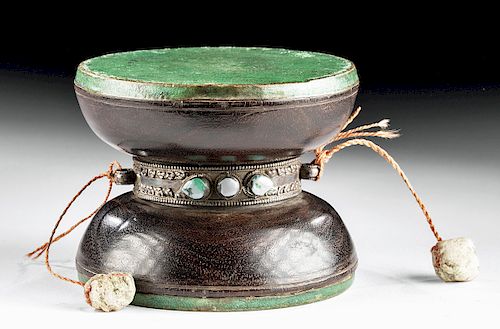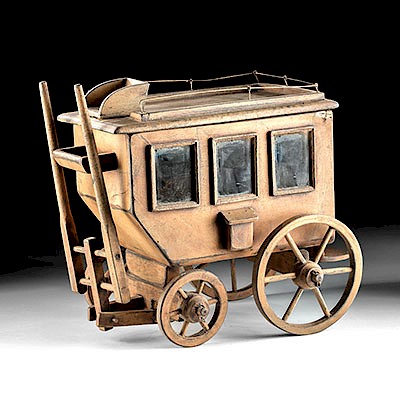19th C. Tibetan Wood Damaru w/ Silver, Turquoise
Lot 202
About Seller
Artemis Fine Arts
686 S Taylor Ave, Ste 106
Louisville, CO 80027
United States
Selling antiquities, ancient and ethnographic art online since 1993, Artemis Gallery specializes in Classical Antiquities (Egyptian, Greek, Roman, Near Eastern), Asian, Pre-Columbian, African / Tribal / Oceanographic art. Our extensive inventory includes pottery, stone, metal, wood, glass and textil...Read more
Categories
Estimate:
$300 - $450
Absentee vs Live bid
Two ways to bid:
- Leave a max absentee bid and the platform will bid on your behalf up to your maximum bid during the live auction.
- Bid live during the auction and your bids will be submitted real-time to the auctioneer.
Bid Increments
| Price | Bid Increment |
|---|---|
| $0 | $25 |
| $300 | $50 |
| $1,000 | $100 |
| $2,000 | $250 |
| $5,000 | $500 |
| $10,000 | $1,000 |
| $20,000 | $2,500 |
| $50,000 | $5,000 |
| $100,000 | $10,000 |
| $200,000 | $20,000 |
About Auction
By Artemis Fine Arts
Nov 14, 2019
Set Reminder
2019-11-14 10:00:00
2019-11-14 10:00:00
America/New_York
Bidsquare
Bidsquare : Ethnographic | Tribal | American Frontier
https://www.bidsquare.com/auctions/artemis-gallery/ethnographic-tribal-american-frontier-4634
Featuring Pre-Columbian, Tribal / Oceanic, Spanish Colonial, historical examples from the Spanish, Mexican, and American frontiers, fossils, and more. All items offered for sale have been legally acquired, are legal to sell and are guaranteed to be as described or your money back. Artemis Fine Arts info@artemisfinearts.com
Featuring Pre-Columbian, Tribal / Oceanic, Spanish Colonial, historical examples from the Spanish, Mexican, and American frontiers, fossils, and more. All items offered for sale have been legally acquired, are legal to sell and are guaranteed to be as described or your money back. Artemis Fine Arts info@artemisfinearts.com
- Lot Description
Central Asia, Tibet, ca. 19th to early 20th century CE. A two-headed drum, known as a damaru (damru), made from two curved wooden half circles that are held together by a strip of 93% silver folded around their upper portions, its ends folded together to form a handle and secured with a silver terminal. This silver strip has tiny repousse leaf motifs, raised borders, and is studded with five inlaid pieces of turquoise. On opposite sites are hooks instead of silver; each has a dangling cord with a sewn hard ball at the end of it that makes a pleasing drumming sound when the instrument is twisted and they hit the skin surface. The skin drum surfaces are both dyed bright green. Size: 3.4" W x 2.6" H (8.6 cm x 6.6 cm)
The damaru drum is used in both Tibetan Buddhism and Hinduism, and in the former it is used in tantric practices as just one of the sacred implements that form their rituals. Traditionally these items are made from a male and a female skull joined at their apex. Although we cannot see inside without destroying the skin; many are inscribed with mantras in gold. They are often played with the right hand, accompanied by a bell in the left hand.
Provenance: Tambaran Gallery, New York, New York, USA; ex-John Freide collection
All items legal to buy/sell under U.S. Statute covering cultural patrimony Code 2600, CHAPTER 14, and are guaranteed to be as described or your money back.
A Certificate of Authenticity will accompany all winning bids.
We ship worldwide and handle all shipping in-house for your convenience.
#149093Rich patina on all surfaces, with light wear commensurate with age. Completely intact and playable.Condition
- Shipping Info
-
All shipping is handled in-house for your convenience. Your invoice from Artemis Gallery will include shipping calculation instructions. If in doubt, please inquire BEFORE bidding for estimated shipping costs for individual items.
-
- Buyer's Premium



 EUR
EUR CAD
CAD AUD
AUD GBP
GBP MXN
MXN HKD
HKD CNY
CNY MYR
MYR SEK
SEK SGD
SGD CHF
CHF THB
THB














